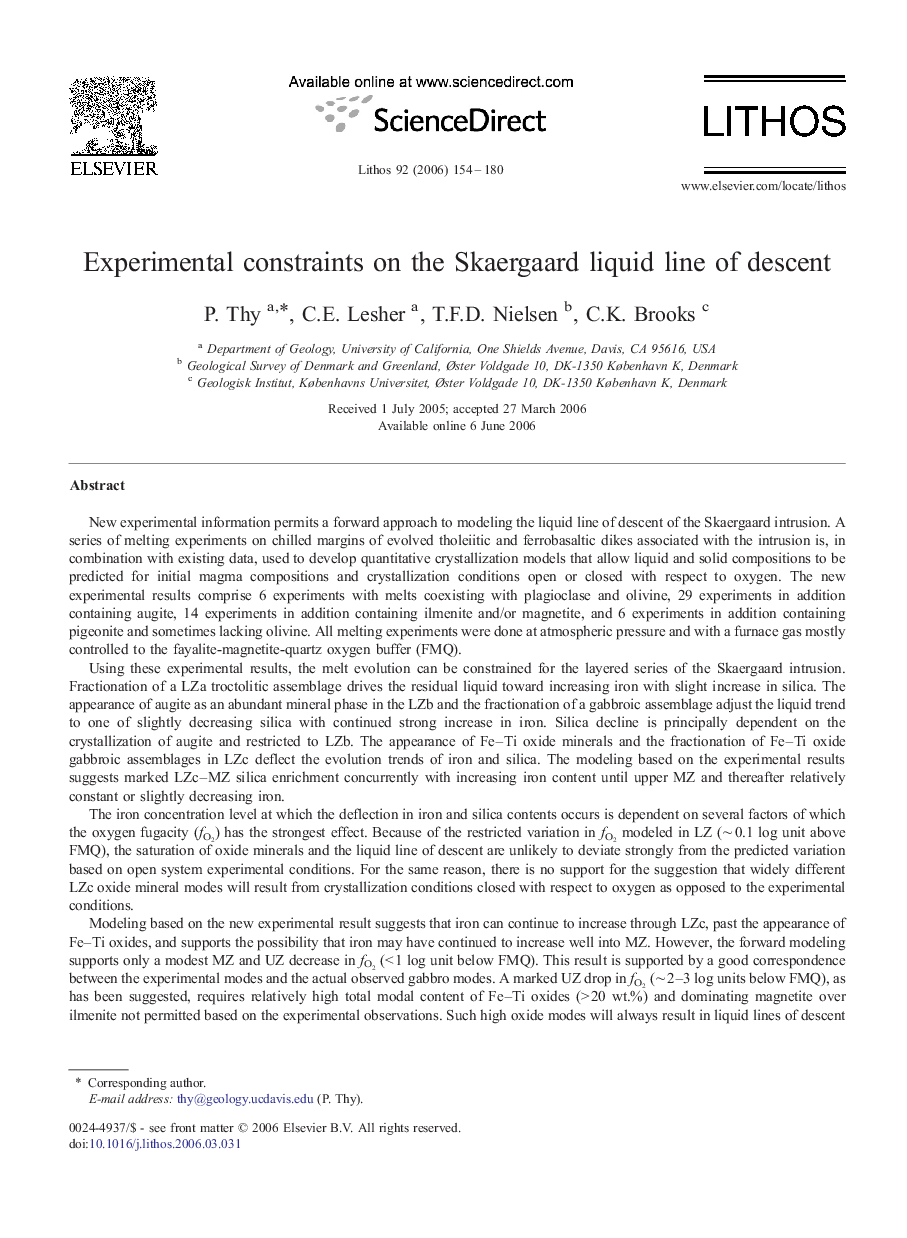| کد مقاله | کد نشریه | سال انتشار | مقاله انگلیسی | نسخه تمام متن |
|---|---|---|---|---|
| 4718018 | 1638775 | 2006 | 27 صفحه PDF | دانلود رایگان |

New experimental information permits a forward approach to modeling the liquid line of descent of the Skaergaard intrusion. A series of melting experiments on chilled margins of evolved tholeiitic and ferrobasaltic dikes associated with the intrusion is, in combination with existing data, used to develop quantitative crystallization models that allow liquid and solid compositions to be predicted for initial magma compositions and crystallization conditions open or closed with respect to oxygen. The new experimental results comprise 6 experiments with melts coexisting with plagioclase and olivine, 29 experiments in addition containing augite, 14 experiments in addition containing ilmenite and/or magnetite, and 6 experiments in addition containing pigeonite and sometimes lacking olivine. All melting experiments were done at atmospheric pressure and with a furnace gas mostly controlled to the fayalite-magnetite-quartz oxygen buffer (FMQ).Using these experimental results, the melt evolution can be constrained for the layered series of the Skaergaard intrusion. Fractionation of a LZa troctolitic assemblage drives the residual liquid toward increasing iron with slight increase in silica. The appearance of augite as an abundant mineral phase in the LZb and the fractionation of a gabbroic assemblage adjust the liquid trend to one of slightly decreasing silica with continued strong increase in iron. Silica decline is principally dependent on the crystallization of augite and restricted to LZb. The appearance of Fe–Ti oxide minerals and the fractionation of Fe–Ti oxide gabbroic assemblages in LZc deflect the evolution trends of iron and silica. The modeling based on the experimental results suggests marked LZc–MZ silica enrichment concurrently with increasing iron content until upper MZ and thereafter relatively constant or slightly decreasing iron.The iron concentration level at which the deflection in iron and silica contents occurs is dependent on several factors of which the oxygen fugacity (fO2) has the strongest effect. Because of the restricted variation in fO2 modeled in LZ (∼ 0.1 log unit above FMQ), the saturation of oxide minerals and the liquid line of descent are unlikely to deviate strongly from the predicted variation based on open system experimental conditions. For the same reason, there is no support for the suggestion that widely different LZc oxide mineral modes will result from crystallization conditions closed with respect to oxygen as opposed to the experimental conditions.Modeling based on the new experimental result suggests that iron can continue to increase through LZc, past the appearance of Fe–Ti oxides, and supports the possibility that iron may have continued to increase well into MZ. However, the forward modeling supports only a modest MZ and UZ decrease in fO2 (< 1 log unit below FMQ). This result is supported by a good correspondence between the experimental modes and the actual observed gabbro modes. A marked UZ drop in fO2 (∼ 2–3 log units below FMQ), as has been suggested, requires relatively high total modal content of Fe–Ti oxides (> 20 wt.%) and dominating magnetite over ilmenite not permitted based on the experimental observations. Such high oxide modes will always result in liquid lines of descent that are characterized by strong enrichment in silica with strong depletion in iron. The forward modeling illustrates that only for unrealistic small amounts of Fe–Ti oxide minerals will iron enrichment accompany silica depletion into UZ.
Journal: Lithos - Volume 92, Issues 1–2, November 2006, Pages 154–180